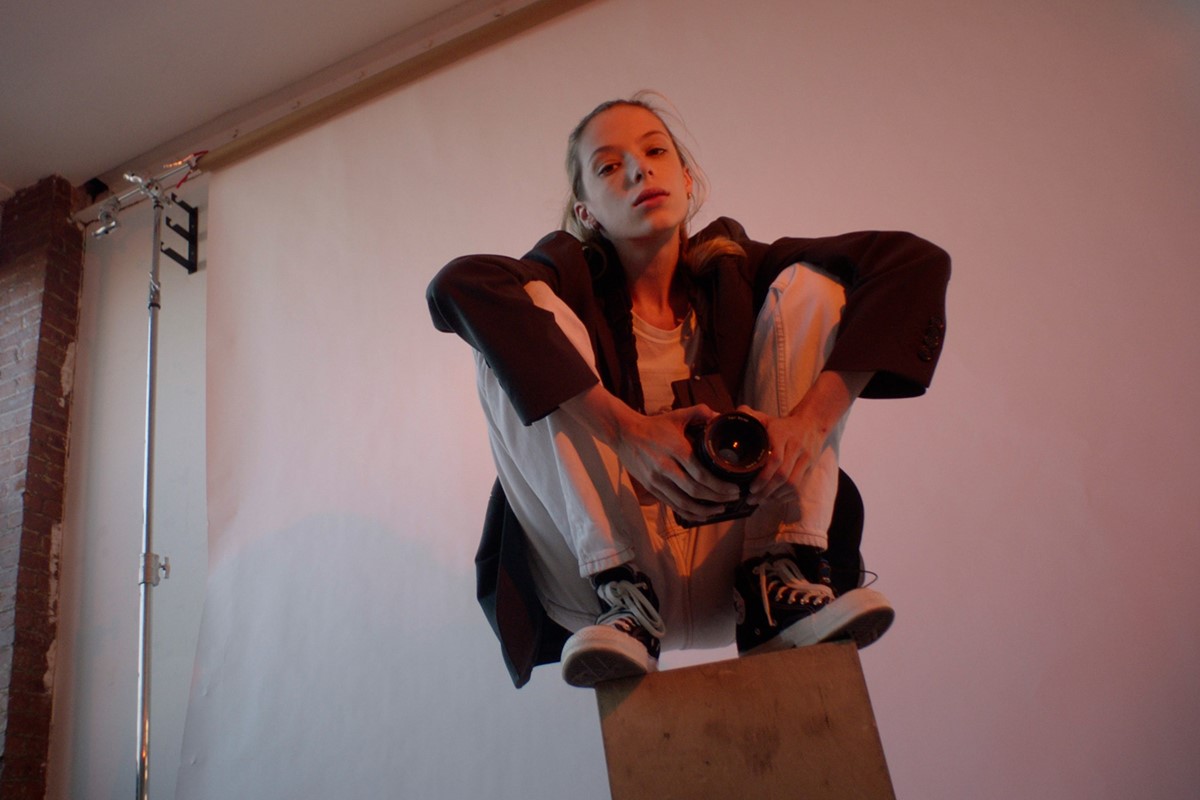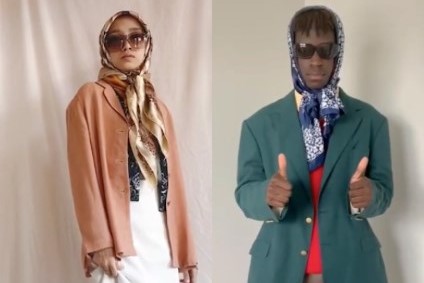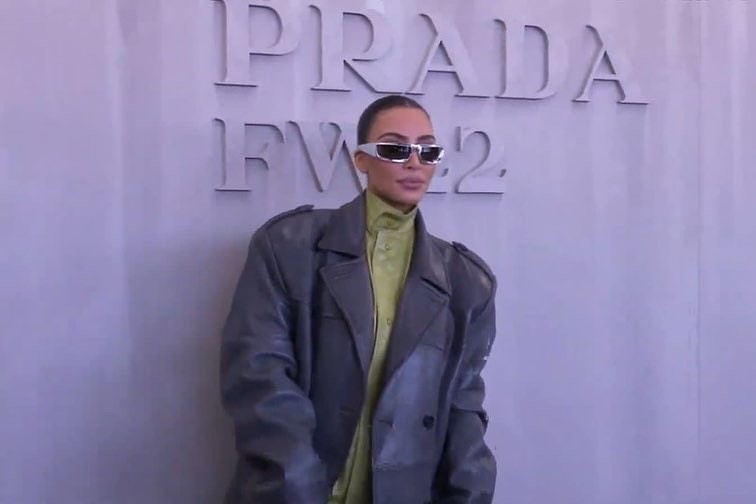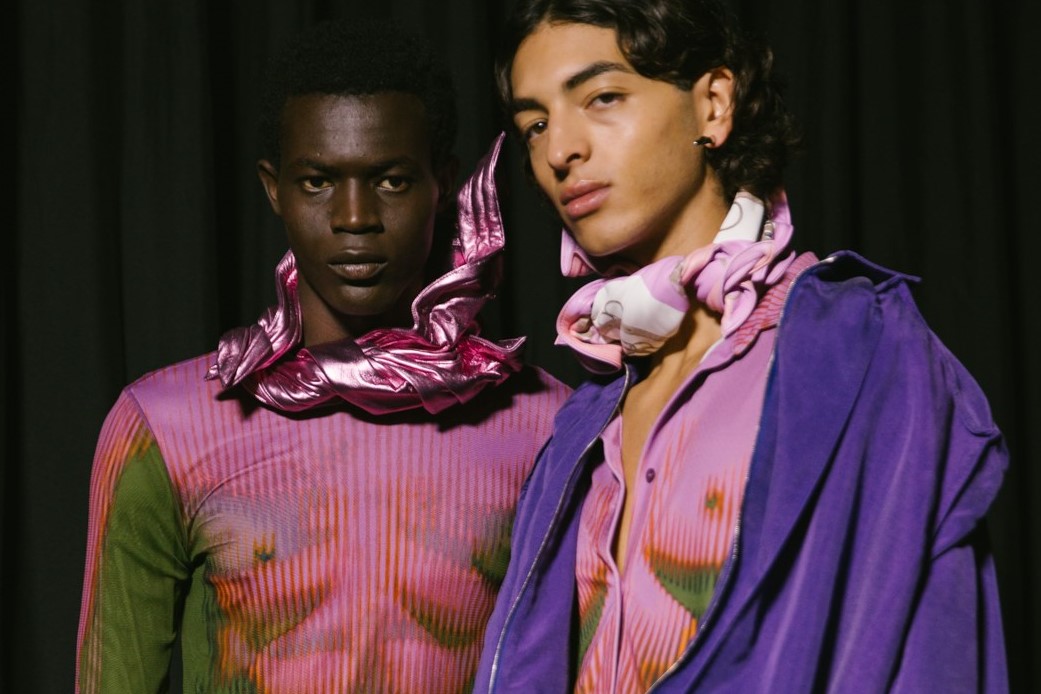
Ella Snyder interviews her photographic hero, Collier Schorr
The young photographer meets one of her biggest influences to discuss photographing the LGBTQ+ community and subverting fashion from within
Converse
For anyone with a marginalised identity, being absent in and erased from mainstream imagery can be painful. Each fighting for that visibility in their own ways are photographers Collier Schorr and Ella Snyder, whose work goes beyond the confines of cisheteronormativity to provide perspectives on gender and identity that have rarely been centred in the worlds of fashion and art.
Schorr, who got into photography when she recognised the need for a lesbian voice in the art world of 1980s New York, has blazed a decades-spanning trail, inspiring generations of young artists to be the change they wish to see in the world. Her images have created an established space for queer voices to speak truth to power through art.
Snyder, meanwhile, is a New York-based model, photographer, YouTuber – and long term superfan of Schorr’s. She is currently working on her first photography book, supported by a grant from the 2020 Dazed 100 Ideas Fund in partnership with Converse. The book focuses on the transgender community and her place within it – a process of restoring a vital connection lost after she began transitioning at the age of 11 and subsequently lived stealth. A decade later, Snyder openly embraces her full identity and uses her talents to create powerful connections within the trans community and the world writ large.
As part of her Dazed 100 takeover, Snyder speaks to Schorr for the first time – in a conversation that captures the innovative, nonconformist spirit that bridges Generations X and Z, the two discuss the ways in which photography can be used as a tool of liberation to reimagine a world where the full spectrum of selfhood can be celebrated.
Ella Snyder: Thank you so much for getting on the phone today, Collier. It’s such an honour to have the opportunity to speak with you. I’ve studied your work at Parsons for the last three years.
Collier Schorr: Thank you for that, I really appreciate it. I don’t 100 per cent have the sense my stuff is taught in school. I know it is but it doesn’t feel that far from when I was in school.
Ella Snyder: Could you tell me more about your journey and how you got started?
Collier Schorr: I went to the School of Visual Arts – it was the only college I could get into. I didn’t study art at all. I went to their first year of a journalism program. I took one class in the photography program taught by Laurie Simmons. That was an important time because there were so many powerful New York women artists: Cindy Sherman, Barbara Kruger, Laurie Simmons, Sarah Charlesworth. They had so much power and presence. It didn’t even occur to us that women couldn’t have the same career. (The next semester, professor) Stephen Frailey showed us 303 Gallery and made an announcement to the class that they were looking for an intern. I got it. I was 21, making $20 a week writing press releases, hanging shows, and curation. Eventually, I asked if I could curate a show of kids I had been in school with. We were also working with other artists. I was working for Peter Halley, then Richard Prince. All of us were making political work and none of us thought about making money from work, it was just about having a voice in the system. (303 Gallery owner/director Lisa Spellman) said I could curate the show and I thought, ‘There’s no lesbian voice in the show,’ let alone the art world that I knew. I thought, ‘I have to make that work.’ It was really that simple.
Ella Snyder: Do you still have a relationship with 303 Gallery?
Collier Schorr: I’m still there but I haven’t shown in New York in years. Once I started doing fashion in a more serious way I treated the magazines like how I used to treat the gallery; it’s a place to plant my voice. I could reach so many more people and I could fuck with the system in engaging ways. It felt like I had a mandate to overturn problematic representations so that very picture I put out in my fantasy was negating or replacing one that I thought was dangerous.
“(Fashion is) a place to plant my voice. I could reach so many more people and I could fuck with the system in engaging ways” – Collier Schorr
Ella Snyder: I feel so similarly about my approach to the photo book I am making and my overall process with photography. It started out as an idea for my senior thesis project at Parsons. I had just publicly come out as transgender. I transitioned when I was 11 and continued my transition through the ages of 16, 17, and since then had been keeping that part of my identity a secret for safety reasons and for fear of not being accepted. I felt like I lost my own place within the trans community. I became very disconnected from it so this book is an attempt to reconnect now that I am in a place in my life where I am so much more comfortable living openly. It’s a celebration of the identities I meet along the way and how it helps me understand my own space in the community.
Collier Schorr: It’s complicated because we yearn for tribes. As humans, we started as tribes, we’re raised in little tribes, and we leave those places to find where we belong. We belong to different tribes in different periods of our life. We seek unity and sometimes that is in conflict with self because we are individuals. As much as we want to identify with a group, feel included and representative of, we’re all very different. I’m a very different lesbian than ten other lesbians.
Ella Snyder: You came into photography trying to create the lesbian voice but I feel like along the way you also really shifted dynamics and portrayals of gender. I was curious about when you started thinking about that.
Collier Schorr: When I started I was appropriating Calvin Klein and Guess ads and using text that talked about going out to bars and chasing girls. Advertising seemed to be holding some gold nuggets of gayness and it was the only place that I could see it. I wanted to put that out in the art world too. There was a bit of attention to queer artists but it felt very landlocked, like I was going to be invited into queer shows as a queer person and that was it. I had a weird reaction to it. The more I was making work, the more I realised I wasn’t there as a spokesperson. I wanted to be an artist. I didn’t want to be only one kind of artist for only one artist. That coincided with me dating a German woman and going to Germany. My work became much more engaged with history, borders, nationality, fetish, a lot of other things. There were many transitions in the work made in Germany over 18 years. When I stopped that relationship, I started living in New York making fashion and returned to the female body. It was a different set of responsibilities and complications.
Ella Snyder: Is that around the same time you made the book 8 Women?
Collier Schorr: That’s the last show I had in New York. 8 Women is meant to be a mini-retrospective of the appearance of the female body in my work. Some are from art works, some are from fashion shoots, some I made in fashion shoots to be able to take out and put into an art context. It was a real fusing of where I came from and where I am. What’s missing from it is the trans influence in my work, which wasn’t on the radar at the time that I made that show. Since I made that I’ve worked with Ari Nickelson, Hari Nef – a whole new group of people came into my world and my work. Andreja Pejic, that was the first person I shot where I did not know who I was and from what place I was coming because I did not know who they were. My feelings could not feel me into something concrete, which is the beauty of transition. Bizarrely I didn’t put that in the show and now I am thinking, ‘What is wrong with me? How is that person not in this show?’ I’m literally in shock right now. It’s such a missed opportunity but I suppose it was one step at a time.

Ella Snyder: There was way less focus on trans identities and trans bodies then. (The photographs I am making for my book) started from looking at the art and fashion worlds and realising that there wasn’t the space that I wanted to take up and wanting to create that space. I am so passionate about the positive representation, trans identities, and trans bodies. I have spent so long without people to look up to – films, icons, and idols. I wanted to create a space that celebrated them that kids like myself could look at, feel inspired and not feel alone. Going into that first shoot with Andreja, how did you approach that shoot from a place of feeling lost?
Collier Schorr: I didn’t feel lost. It was more I felt unhinged from a structure I was used to. I was in front of someone with no preconceived guidelines for desire and, desire is always a part of my work: desire, guilt, and envy. It’s like a revolving dance of those feelings, not really anymore but in those earlier years, I had a fear that women in front of my camera would feel like I was desiring them too much and I would feel shame. That changed when I shot Freja for i-D. That was a huge moment for both of us because we could be lesbians in a room making pictures, and I could think she was beautiful and she could feel that and feel good with it and feel I understood her. It was a real journey for me to feel accepted by women I was shooting. With boys I had a certain kind of love, envy, and worship. I could compliment them all day long and they would laugh because I was not a threat. When I shot Andreja, I remember wanting to make pictures that were female and make pictures that were male and watching the blur happen.
“I’m a Scorpio. It’s 100% all the time, no matter what” – Collier Schorr
Ella Snyder: How do you view photography as a vehicle for change?
Collier Schorr: The watershed moment where my rhetoric lined up with reality is when there were billboards of Selena Forrest kissing Hiandra Martinez for Saint Laurent. I imagined girls walking down the street with their mother or father and those parents seeing that billboard and thinking, ‘Okay. I guess it’s okay.’ It felt like a beacon of hope and nobody can take that away from us. The most important to me is to show intimacy between the subject and the photographer and that the person in the picture has autonomy. It doesn’t have to change the world – it’s just that when people glance at a picture they see a human being. When we see human expressions, we feel better in some small ways.
Ella Snyder: Being able to see someone else represent those actions, those emotions, and that mentality overall is a force for change because it normalises things that may have been marginalised before. How do you find that balance and personal connection to the work when you are going between fashion/commercial work that’s paid and personal projects that are passion, what you want to be doing?
Collier Schorr: Well I’m a Scorpio. It’s 100% all the time, no matter what.




